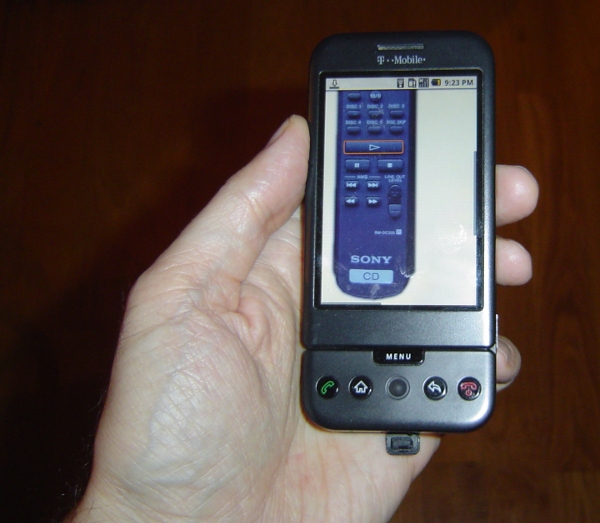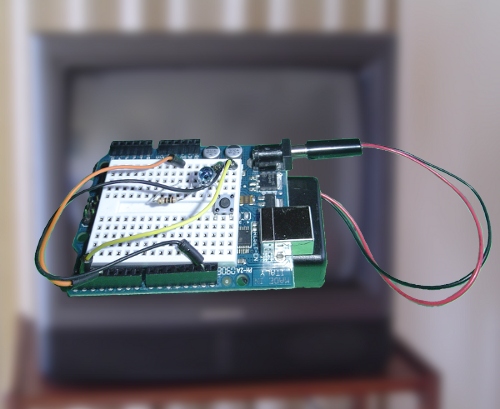In my stereo controller system, I go to a web page that has an image of the appropriate remote control, and click the button. The Javascript in the web page sends a hex code back to the server, which sends the code to an Arduino microcontroller board, which converts the code into an infrared signal. The stereo interprets this signal as a command from the remote control and performs the desired action. It sounds complicated, but it responds quickly, even if I use the browser on my cell phone. I wrote up more details on the system earlier.

The web server for this project is fairly straightforward: it needs to serve some static HTML pages and images, and needs to receive POST messages and forward the data over the serial port to the Arduino. I originally wrote the code in Python:
import cgi
import serial
from BaseHTTPServer import HTTPServer
from SimpleHTTPServer import SimpleHTTPRequestHandler
class MyHandler(SimpleHTTPRequestHandler):
def do_POST(self):
if self.path == '/arduino':
form = cgi.FieldStorage(fp=self.rfile, headers=self.headers,
environ={'REQUEST_METHOD':'POST'})
code = form['code'].value
print 'Sent:', code
arduino.write(code)
self.send_response(200)
self.send_header('Content-type', 'text/html')
return
return self.do_GET()
arduino = serial.Serial('/dev/ttyUSB0', 9600, timeout=2)
server = HTTPServer(('', 8080), MyHandler).serve_forever()
The Python web server is based on SimpleHTTPServer. To handle POST requests to the /arduino URL, I made a simple handler subclass that pulls the data out of the response, sends it to the serial port, and returns a blank response. The last two lines open the serial port and start up the server. The static web page serving comes "for free."
After writing this, I decided to try writing a version in Arc:
(= srvops* (table))
(= arduino-serial (outfile "/dev/ttyUSB0" 'binary))
(defopr || req "/index.html")
(defop arduino req (w/stdout (stderr)
(let code (arg req "code")
(write code arduino-serial)
(prn "Sent code:" code))))
(thread (serve 8080))
Since you may not be familiar with the Arc web server, I'll give a brief explanation. The first line clears out the server's default pages (login, whoami, prompt, etc) that make sense for news.yc, but not for me. The next line opens the serial port. Next, the mysterious || redirects the home page. The next four lines are the handler for "/arduino": the "code" parameter is pulled out of the request (req). The code is written to the serial port, and printed to the log. The last line starts a serving thread on port 8080.
I'm not going to count tokens since that's a silly metric, but the Arc code is a clear winner here. The first Python disadvantage is the hideous cgi.FieldStorage call to parse the POST data; apparently this is the way to do it, but it took me considerable time to get this right. The second Python disadvantage is the necessity to set up the return code and content-type for the response. I ended up with a browser-specific bug when I didn't have this right, since some Javascript interpreters expect a particular response. Arc automatically sends a valid response. The main Arc disadvantage is there's no real serial port support; the Arc code just opens the port and hopes for the best. On the other hand, Python's serial library lets you set the baud rate, timeouts, and other parameters.
Arc and Python have a few more minor differences. Python requires imports, which Arc doesn't. Arc has the silly clearing of srvops* to avoid unwanted pages. Starting the server thread is simpler in Arc but not as flexible.
To summarize, I found the Python code difficult and error-prone to write, and the Arc code was shorter and just worked. This was a surprise to me; usually I find Python straightforward and Arc gives me pain when I have to write a bunch of code for some trivial thing it doesn't support. (For example, generating a time string in my temperature monitoring.) In this case, however, Arc came out ahead. Perhaps this is because Arc's flagship application is a web server, so it handles web serving well.
Obviously this is a fairly trivial program - the complexity is actually in the Javascript code and the C++ code on the Arduino - so I'm not claiming this as an overall victory for Arc over Python. But it's still interesting to find Arc came out ahead in this case.
